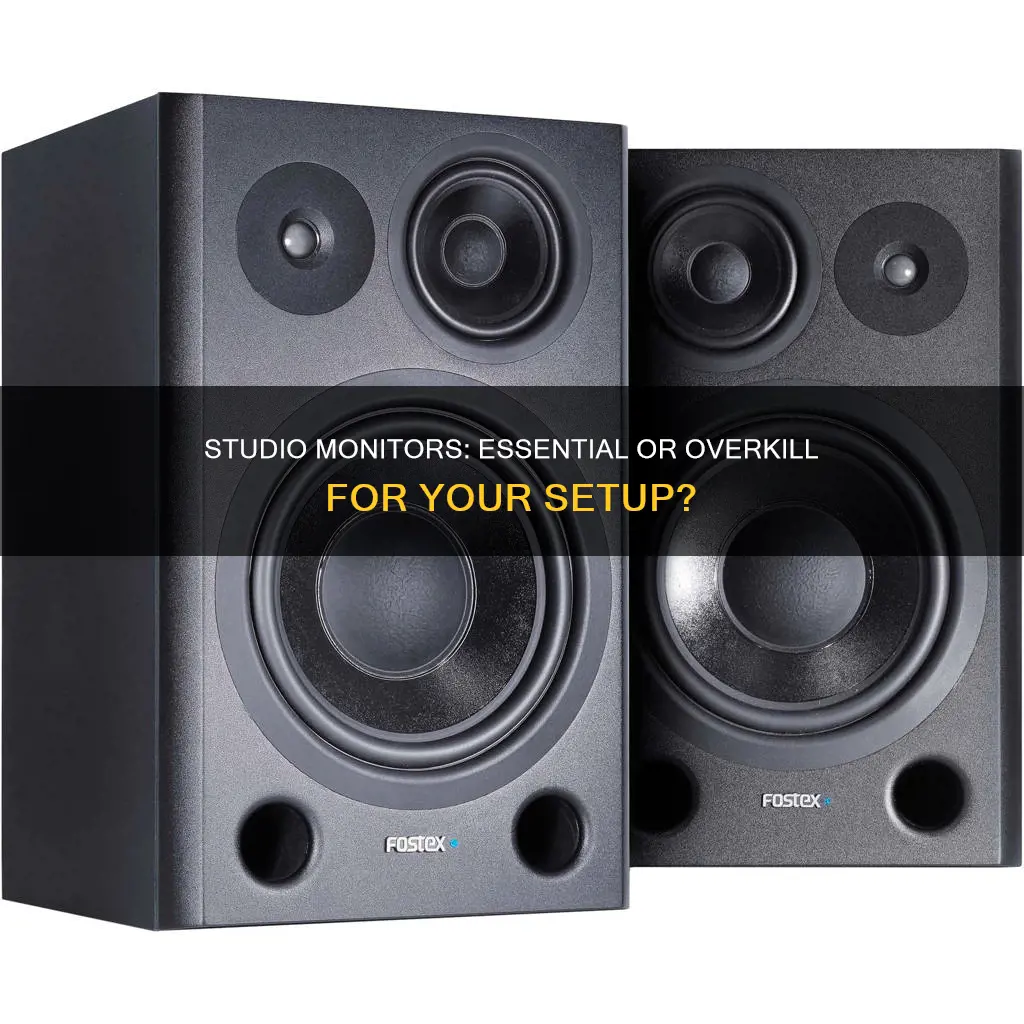
Studio monitors are loudspeakers designed for audio production applications such as recording, mixing, and broadcasting. They are different from consumer-level loudspeakers in that they have a flat frequency response and a wider dynamic range, meaning they provide a more accurate representation of what is being recorded or edited. This is because they do not favour or smooth out any frequency, instead delivering an uncoloured sound. Studio monitors are also built more robustly than Hi-fi speakers, which are often only designed to reproduce compressed commercial recordings.
However, some people argue that studio monitors are not necessary, especially for beginners or those not planning to release their recordings commercially. It is possible to produce music without studio monitors, but the equipment used will impact the quality of the sound.
| Characteristics | Values |
|---|---|
| Purpose | To hear a "true" and "honest" representation of what is being recorded or edited |
| Difference from regular speakers | Studio monitors aim to be "flat", i.e. they don't favour or smooth out any frequency |
| Placement | Should be placed on dedicated stands with isolation pads to prevent vibration and comb-filtering |
| Distance from user | Near-field monitors are placed around one to two metres away from the user |
| Angle from user | The two monitors are angled so the sound is directed towards the user's head |
| Type | Active monitors are more common and convenient than passive monitors as they have built-in amplifiers |
| Wattage | Higher wattage produces clearer and more detailed sound |
What You'll Learn
- Studio monitors are designed to be as flat as possible, meaning they won't favour or smooth out any frequency
- Studio monitors are built to be more robust than Hi-fi speakers, which are designed to reproduce compressed commercial recordings
- Studio monitors are usually active, meaning the amplifier is built into the monitor
- Near-field monitoring is the most common setup for home studios
- Studio monitors are placed to form a triangle with your head when listening to them

Studio monitors are designed to be as flat as possible, meaning they won't favour or smooth out any frequency
Studio monitors are designed to have a flat frequency response, meaning that all frequencies are played at the same volume level. This is in contrast to regular Hi-Fi speakers, which are "biased" and altered to emphasise certain frequencies, such as adding more bass to music.
Studio monitors aim for a flat frequency response to give a true representation of the sound, ensuring accurate mixing and mastering. This means that no frequency is favoured or smoothed out. Studio monitors are designed to be as accurate as possible when it comes to reproducing frequencies.
The flat response of studio monitors allows producers to accurately balance the levels of different frequencies in the audio, which is crucial when mixing. If a speaker boosts the bass and treble, the producer might be tricked into thinking their mix is well-balanced when it is not. They might then compensate by reducing those frequencies in their mix, causing the final product to sound wrong on other systems.
Studio monitors are also designed to deliver a perfectly balanced audio response. This is not necessary for outdoor party speakers, which are designed to deliver a higher level of bass and keep the energy of a crowd going.
Studio monitors are specifically designed for use in recording studios, radio stations, and other professional audio environments. They are used to mix music, dialogue, and sound effects during the recording, mixing, and mastering processes.
Midfield Monitor Size Specifications for Your Studio
You may want to see also

Studio monitors are built to be more robust than Hi-fi speakers, which are designed to reproduce compressed commercial recordings
Studio monitors are an essential part of any studio setup. They are designed to provide a "flat" frequency response, meaning that all frequencies are outputted equally and nothing is boosted or cut. This is in contrast to Hi-fi speakers, which tend to boost the low-end and high-end frequencies, giving the music a positive shine. Studio monitors are built to be more robust than Hi-fi speakers, which are designed to reproduce compressed commercial recordings. They feature tough and sturdy housing and stronger speaker cones to cope with the demands of the studio.
The physical construction of studio monitors is more durable because they are designed to handle constant low-frequency work. For example, a producer may work on a bass sound for several hours, playing the same phrase over and over to get it right. Studio monitors need to be able to withstand this kind of constant use without distorting the sound.
In addition to their robust construction, studio monitors also have a wider dynamic range than Hi-fi speakers. This means they can handle the high variations in sound levels often found in music, such as a sudden drum introduction. Studio monitors are designed to provide an accurate representation of the audio being produced, with no boosts or cuts from the monitors themselves. This is essential for creating high-quality recordings and mixes.
While studio monitors are an important part of any studio setup, they are just one piece of the puzzle. The room in which the monitors are placed can also have a significant impact on the overall sound. It is important to consider the size of the room and treat it acoustically to ensure accurate monitoring. Additionally, it is recommended to sample mixes on different platforms, such as cheap speakers or headphones, to get a comprehensive evaluation of the final product.
Monitoring Calories and Portions: A Health Priority
You may want to see also

Studio monitors are usually active, meaning the amplifier is built into the monitor
Studio monitors are an essential part of your studio setup and can significantly impact the quality of your productions. They are designed to deliver a flat frequency response, meaning all frequencies are outputted equally, and nothing is boosted or cut. This is in contrast to consumer-level loudspeakers, which tend to "colour" the sound by emphasising certain frequencies to enhance the listening experience. Studio monitors are also built to be more robust than hi-fi speakers to cope with the demands of the studio.
Active studio monitors are widely used, especially in concise setups and home studios. They provide a convenient and simple solution, as you only need to connect them to your interface or a power outlet. However, some people prefer the combination of passive monitors and an external amplifier, as it offers more flexibility in terms of customisation and sound tuning.
When choosing between active and passive studio monitors, it is essential to consider your specific needs and preferences. Active monitors are generally more cost-effective and easier to set up, making them a popular choice for home studios and beginners. On the other hand, passive monitors allow for more customisation and can be paired with a high-quality amplifier to achieve superior sound performance. Ultimately, the decision depends on your budget, the complexity of your setup, and your audio engineering skills.
Tracking Performance Metrics for Effective Improvement Strategies
You may want to see also

Near-field monitoring is the most common setup for home studios
The proximity of near-field monitors to the listener means that the sound stage will be directly in front of them, with a centred stereo image that can assist in mixing. However, it is important to note that room symmetry and speaker positioning play a crucial role in achieving this balanced sound stage. Speakers should be placed at a minimum distance of 3 feet from the sidewall and front wall, with unequal distances between the front and back walls. The right and left channels should be mirror images in terms of distance from the listening position.
The benefits of near-field monitors make them a popular choice for home studios, where space may be limited and room acoustics may not be optimal. They allow for detailed work on mixes and provide a listening experience closer to that of the average consumer.
Monitoring Power Usage: Strategies for Energy-Efficient Businesses
You may want to see also

Studio monitors are placed to form a triangle with your head when listening to them
Studio monitors are a vital piece of equipment for any audio engineer or music producer. They are designed to provide a flat frequency response, meaning all frequencies are outputted equally and nothing is boosted or cut. This results in a true representation of the audio being recorded or edited, allowing for more precise mixing and production.
When setting up studio monitors, it is important to ensure that they are placed correctly for optimal performance. One key aspect of this is forming an equilateral triangle with your head when listening to them. The monitors should be angled so that the sound is directed towards your head, with each monitor pointing to its corresponding ear. This setup ensures a clear stereo picture and helps to minimise the impact of the room on the sound.
The distance between the two monitors should also be equal to the distance from your head. This configuration is known as near-field monitoring and is commonly used in home studio setups. It allows for more direct sound that is less affected by the acoustics of the room, which is particularly important if the room is not acoustically treated.
In addition to the triangle setup, it is recommended to place the monitors on dedicated stands with isolation pads to prevent vibrations and comb filtering. This further contributes to achieving an accurate and detailed sound from the monitors.
By following these placement guidelines, you can ensure that your studio monitors provide you with the best possible listening experience for mixing and production.
G-Sync Monitor Buying Guide: What to Consider
You may want to see also
Frequently asked questions
Studio monitors are loudspeakers specifically designed and engineered for audio production applications such as recording, mixing and broadcasting. Studio monitors are necessary as they provide a more accurate image of what is being recorded or edited, revealing flaws or problems in a recording more effectively than a consumer-level speaker.
Studio monitors are designed to have a flat frequency response, meaning all frequencies are outputted equally and nothing is boosted or cut. This means that what you hear is a true representation of what your mix and production sound like. On the other hand, hi-fi speakers tend to "colour" the sound, as they boost low-end and high-end frequencies to give a better listening experience.
Some popular options for studio monitors include the Yamaha HS Series, KRK Rokit G3, and Behringer's B2031A.







